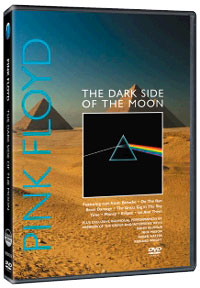


Near the End
Even though the Floyds have kept quiet lately, there are still new discoveries for fans to make
As you may or may not have heard, Nick, Rick, and Dave played some music together in public, marking the first time they've done so in nearly a decade. The occasion, however, was less than a celebratory one, at least in the cheerful sense, as they played to honor the passing of longtime manager and friend Steve O'Rourke. A chance, if you will, to mark history with a small tribute. So let's talk history. Seems like a good time for it. This past month has seen some absolutely stunning releases from the band that Mr. O'Rourke worked so hard to promote over the years, releases that offer powerful insights into the history of the band--some obvious, some you'll have to dig for.
 Storm Thorgerson and his design team built and photographed an actual stained glass window modeled after the original Dark Side artwork for the 30th anniversary SACD issue. |
Earlier this year saw the release of what my pal (and former Spare Bricks editor) Rick Anderson would likely characterize as "yet another effin' re-re-re-release of the same old material." The arrival of Dark Side of the Moon on Sony's Super Audio CD format, however, is more than that, to some fans at least. Rick is, you see, missing the point, since this release is markedly different from any previous edition of the album, up to and including the Quad release back in the heady days of vinyl. Admittedly, it is "merely" a remix of the same material, but since the five Floyds aren't producing any new music collectively, what's the gripe? No one's holding a gun to anyone's head to force us to buy this, and those of us who revel in surround sound get a chance to hear a beloved album in a new way.
I proudly (sort of) count myself as one of those types, also known as the "audiophile". To a point. I am well aware of the hell that is reserved for obsessive audiophiles, although it is strictly a hell of their own making, spending a fortune on cables and scouring record bins for that rare Japanese release on virgin 140 gram vinyl. I suspect that many of these people have trouble getting to sleep unless they've flipped the light switch a specific number of times and checked the stove repeatedly. But I digress. Myself, I am more just the type who enjoys the unique sensation that comes from being enveloped in high-quality music coming from good speakers or headphones, of the pleasure that can be derived from hearing things you've never caught before in a recording that you thought you knew backwards and forwards.
As such, the Dark Side SACD is a boon, or it would be if I actually had the good fortune to own a Super Audio-capable player. Instead, I either have to pester the local audiophile store to let me listen to it there for the Nth time even when the owner knows I am unlikely to actually purchase anything, or fool myself into believing I can pick out new things from the plain old CD layer that the rest of us are stuck with. Which isn't entirely impossible or wrong-headed: When you've listened to an album as much as I have with Dark Side, it is easy to take it for granted. Forcing yourself to listen to for new information could very well break through that barrier of expectations and habit.
 |
On that same front, the new release of Classic Albums: Dark Side of the Moon is even better. This DVD, one in a series of releases of a fascinating British program, puts us in the mixing booth with the album's creators, who get the chance to point out history, nuance and insight that very few but they could ever be privy to. And things like hearing the vocal harmonies on "Breathe" broken down, or seeing David recreate the VCS3 programming for "On the Run" can be inspire amazement, if not awe. So that's what I've been listening to all these years? Wow. These guys are good.
Also fascinating is the chance to get a little context on the album, even if most of it is stuff familiar to most hardcore Floyd fans. Things like the evolution of "Us & Them" and "On the Run" from their earlier incarnations are well-worn history, but the Classic Albums show manages to eek a little more mileage out of them by showing Rick demonstrate and explain his chord choices on a grand piano. Who here knew Dark Side of the Moon had ties to Miles Davis' Kind of Blue? I certainly didn't, until now.
Still, before this turns into an infomercial, I found some of the tics of modern editing disappointing, although many of them are rectified in the bonus features, meaning we get full versions of songs like Roger's acoustic version of "Money". But most frustrating, they cut off Rick's solo instrumental performance of "Us & Them", which is disappointing, although understandable. Admittedly, watching him perform a solo piano version of the song might be a bit boring to some, but I found myself wishing I could have an entire album of just this man's piano playing.
We also get some frustrating teases of some enticing gems from the Floyd vault, like demo recordings, live recordings, and even some filmed live footage. What I always find myself wanting to know is, why is this stuff just sitting around, and why haven't I seen it before? For me, one of the ways I continue to stay interested in the band, even as their output dries up into re-re-re-releases and "Best Of" collections, is to dive deeper into the evolution of the material, which inevitably means tracking down rarities and live recordings (thankfully, much easier now with the Web). But hearing similar keyboard textures move from a track on one album to a live performance of another song yet-to-be recorded gives me a peek into the thoughts and methods of the band members. But such glimpses and insights can be rare.
That is why it is especially amazing that the last year or so has witnessed the (unofficial) release of "Work in Progress" mixes of The Final Cut and, even more enticingly, The Wall. Understandably, Waters and company are reportedly none-too-thrilled that these versions have been leaked to the public, but I hope everyone understands that most people who would seek something like these down will listen with the forgiving ears of a fan. Yes, Waters' singing is at times painfully off-key, but the passion is indisputably there. The "Work In Progress" of The Wall is rough, naturally, but it shows us that albums like these do not spring full-grown from some mechanical factory; rather, they are finessed and carefully molded, as a work of art should be.
Now, one could argue that hearing these details detracts from the listening experience of the masterpieces themselves. Knowing, for instance, exactly what the ranting demagogue is saying over his megaphone in "Waiting for the Worms" might lead one to concentrate on the minutia rather than the whole. This is a valid argument, but I suppose that, in the end, it's up to the individual listener to decide what level of involvement is best for them. It is nice to have the choice, however, and a little unfortunate we don't have the same document for all Floyd albums. Although, we in many ways we do, with all the live recordings out there, don't we?
Now that the band is effectively defunct (although the performance at Mr. O'Rourke's funeral raised hopes for some that this might spur some new material or shows), we now have more materials than ever with which to experience the band's music, except, ironically, the band itself. I suppose it's time to make our peace with the end of the Pink Floyd as we know it, just as we have done when Syd and Roger both made their exits. However, this time seems more finite than ever before. As David once put it, when something works, you don't want to mess with the ingredients too much. Who knows how much of a driving force Steve was? Only the men themselves, naturally, but if he was the key component that kept them moving forward with new music and tours, then this could very well be It, with a capital "I." And it's not like they haven't given us an amazing legacy to enjoy. The fact that one album could support multiple releases, innumerable magazine articles, live performances and cover versions, and an extended documentary detailing its construction is nothing short of astonishing. How many other albums in your collection can boast that level of examination? And how many hours of pleasure has this one work brought you and millions of others?
No small legacy to leave behind if you ask me, and I, for one, would like to thank them. And though it may be late, thank you, Steve, for your part as well. God bless.